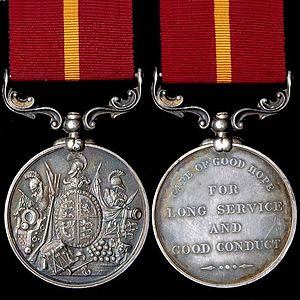Army Long Service and Good Conduct Medal (Cape of Good Hope)
| Army Long Service and Good Conduct Medal (Cape of Good Hope) | |
|---|---|

Queen Victoria version
|
|
| Awarded by the Monarch of the United Kingdom of Great Britain and Ireland, and Empress of India | |
| Country |
|
| Type | Military long service medal |
| Eligibility | Permanent Force Other Ranks |
| Awarded for | 18 years service and good conduct |
| Status | Discontinued in 1910 |
| Statistics | |
| Established | 1896 (Victoria) 1901 (Edward VII) |
| Order of wear | |
| Next (higher) |
|
| Equivalent |
|
| Next (lower) |
|
|
Ribbon Bar |
|
In May 1895, Queen Victoria authorised Colonial governments to adopt various British military medals and to award them to their local military forces. The Cape of Good Hope introduced this system in September 1895 and, in 1896, instituted the Army Long Service and Good Conduct Medal (Cape of Good Hope).
The United Kingdom's Army Long Service and Good Conduct Medal was instituted by King William IV in 1830. The original version had the Royal Coat of Arms with the badge of Hanover on the obverse, while on the Queen Victoria version, introduced upon her succession to the throne in 1837, the Hanover emblem was replaced by a Trophy of Arms which incorporated a central shield bearing the Royal Coat of Arms. Upon the succession of King Edward VII to the throne in 1901, his effigy was placed on the medal's obverse. The medal's ribbon was plain crimson from 1830 until 1917, when white bands were added to the edges.
The medal was originally awarded to soldiers of good conduct who had completed 21 years of service in the infantry or 24 years in the cavalry. From 1870, the qualifying period was reduced and the medal was awarded to soldiers of good conduct who had completed 18 years of service.
In the late 19th century, the military forces of the Cape of Good Hope, colloquially also known as the Cape Colony, consisted of three separate military organisations, the permanent para-military Frontier Armed and Mounted Police and two part-time forces, the Burgher Force and the Volunteer Force, both district-based. These Cape Colonial Forces were established in 1855, after the United Kingdom granted the Cape of Good Hope representative government in 1853.
On 31 May 1895, Queen Victoria authorised Dominion and Colonial governments to adopt various military medals and to award them to their local military forces. The Cape of Good Hope introduced this system in September 1895. In 1896, one of three known medals which were instituted by the Cape in terms of this authority was the Army Long Service and Good Conduct Medal (Cape of Good Hope). The Cape medal ranks on par with its British counterpart in the order of wear.
...
Wikipedia
